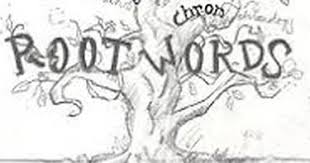 The Greek Titan Chronos is known as the son of Uranus (Heaven) and Gaea (Earth), the youngest of the 12 Titans, the one who separated Heaven from Earth, and the one who ate his godly offspring. On top of all that, his name literally means TIME in Ancient Greek. The Greek root CHRON, old as it is, forms the basis of some interesting time-oriented words still used today. CHRONOLOGY - a record of events or dates in order of occurrence (Teachers often ask students to list historical facts in chronological order.) CHRONIC - constant, acute (Did you know that millions of people suffer from chronic bronchitis?) ANACHRONISM - hails from a previous time period (In literature, a common anachronism is dropping a character into a different time period.) CHRONICLE - written account of a series of events, usually nonfiction (Newspapers chronicle each day's most important events on their front pages. This is known as front page news!) SYNCHRONIZE - cause to occur at the same time or rate (Don't you just LOVE to watch synchronized swimming?) CHRONOMETER - a marine instrument for measuring time (The chronometer manages to keep accurate time despite weather and motion fluctuations.) Now it's TIME to enjoy the beach, vacation with family, relax in your backyard, host a cookout, read, write, volunteer, go to camp, walk the dog, hit the outlets, run a 5K, or whatever makes your heart sing. Enjoy! Sincerely, Laura Fineberg Cooper
1 Comment
 Much of our language is derived from Greek and Latin roots, and the more roots you learn, the easier it will be to decode unknown words. In honor of the last spoonful about HOMOPHONES, this highlights ten words derived from the Greek root PHON (sound). HOMOPHONE = HOMO (same) Definition: words that sound the same but typically have different meanings and spellings TELEPHONE = TELE (far, far away, distance) Definition: a device that transmits sound over a distance SYMPHONY = SYM or SYN (together). Definition: harmonious musical composition for a full orchestra PHONICS = ICS (a body of facts, knowledge, or principles) Definition: a way to teach reading that breaks words into letter sounds XYLOPHONE = XYLO (wood) Definition: wooden bars struck by mallets to produce sound EUPHONIUM = EU (good, well); EUPHONOS (sweet-voiced) Definition: like a tuba with a tenor voice MICROPHONE = MICRO (small, tiny) Definition: small device that amplifies voices or other sounds CACOPHONY = KAK (bad) Definition: = harsh, discordant mixture of sounds MEGAPHONE = MEGA (very large) Definition: = large device that makes loud voices even louder PHONOGRAPH= GRAPH or GRAPHY (to write) Definition: = machine that can convert records to sound FUN FACT: Both the SAXOPHONE and SOUSAPHONE are named after their creators. Belgian inventor and musician Adolphe Sax might not be a household name, but I'm sure many of you are familiar with American composer/conductor John Philip Sousa and his military marches! Happy Summer! I hope you enjoyed this spoonful. Sincerely, Laura Fineberg Cooper  In honor of my 20th Spoonful, it's time for some HOMOPHONE fun! So what are HOMOPHONES? Words that sound (phone) the same (homo) but have different meanings, origins, and/or spellings. Determining which is (witch) which can cause much confusion. There are lots of HOMOPHONES, but the most commonly used and confused ones include CONTRACTIONS. Instead of telling you which definition belongs with which word, you'll have a chance to match them yourselves. Answers will be given at the end. No peeking!! 1.)ITS 2.)IT'S One means "belonging to it" and the other means "it is." 3.)THEIR 4.)THEY'RE 5.)THERE One means "they are," another means "belonging to them," and the third means "Where? Not here but over _______.) 6.) YOU'RE 7.) YOUR 8.) YORE One means "belonging to you," another means "you are," and the third means "in days gone by." 9.) WE'VE 10.) WEAVE One means "knit, thread, or wind" and the other means "we have." ANSWER KEY: 1.) ITS = belonging to it (the possessive form) 2.) IT'S = it is 3.) THEIR = belonging to them 4.) THEY'RE = they are 5.) THERE = Where? Not here but over there. 6.) YOU'RE = you are 7.) YOUR = belonging to you 8.) YORE = in days gone by 9.) WE'VE = we have 10.) WEAVE = knit, thread, or wind WORD OF ADVICE: Whenever you see a CONTRACTION, break it apart. If "it is," "you are," or "they are" works in your sentence, then "it's," "you're," or "they're" will also work. Trust me, its vs. it's (and other HOMOPHONE pairs like that) WILL appear as questions in the PSAT/SAT/ACT Writing Sections! If you follow this tip, you'll easily determine the correct answers. I hope you found this spoonful helpful and a wee bit of fun. I aim to help writers of all ages, and welcome you to share this blog with your friends and family. Sincerely, Laura Fineberg Cooper JURY FAMILY CLASS AUDIENCE ARMY TEAM MAJORITY COMMITTEE DEPARTMENT GROUP COMPANY SOCIETY FLOCK
PACK COMPANY HERD CREW TROUPE STAFF CHOIR GANG What do the above nouns have in common? Each represents a group (or collection) of individuals, animals, or things. It just so happens there's a special term for nouns like these: COLLECTIVE NOUNS. Unlike with COMMON NOUNS such as dog, tree, and book, it can be tricky to determine whether a COLLECTIVE NOUN is singular or plural. But if you ask yourself the following question, your confusion will be cleared! Are you writing about a group as a whole OR focusing on the individual members within? If your answer is the group as a whole, treat the COLLECTIVE NOUN as SINGULAR. If your intent is to focus on the group's individual members, treat the COLLECTIVE NOUN as PLURAL. Below are some examples to demonstrate the difference. Since the plural treatment can sound a bit awkward to the ear, I'll also show you alternative suggestions for those. TEAM as a group The team is ranked first in its division. (is, its = SINGULAR) TEAM as individual players The team lace up their sneakers. OR: The team members lace up their sneakers. (lace, their = PLURAL) JURY as a unit The jury has reached a verdict. (has = SINGULAR) JURY as individual jurors The jury hail from all walks of life. OR: The jurors hail from all walks of life. (hail = PLURAL) FAMILY as a unit My family lives in Massachusetts. (lives = SINGULAR) FAMILY as individual members My extended family are scattered across the globe. OR: My extended family members are scattered across the globe. (are = PLURAL) Notice how two of the plural examples added the word members after the COLLECTIVE NOUN? Here are some other possibilities for describing individuals: participants, employees, recruits, sopranos, and players. Can you think of any more? Have fun with it! I hope you enjoyed this spoonful. Please feel free to share! Sincerely, Laura Fineberg Cooper  The last two spoonfuls covered dialogue tags placed first and last. But plunking dialogue tags in the middle can be useful, especially when characters have a lot to say. For the finale, I bring you DIALOGUE TAGS IN THE MIDDLE(Comma Rule #9)! Let's dive in with some examples. #1: "Everybody pack up your desks," Mrs. Rankin ordered, "and then line up quietly in front of the door." #2: "90 steps completed," Johanna said after catching her breath, "and 60 to go." EXPLANATIONS: In both examples, the quoted sentence is continued after the dialogue tag. In cases like these, place a comma at the end of the first quote AND after the tag. Because the second quote is a continuation, start it with a lower case letter and place the period inside the end quote. #3: "Are you going to the party?" Mariana asked, batting her eyelashes and flipping her hair. "I'll be there, so it's going to be a blast." #4: "Awesome sauce!" Jenna squealed. "Count me in!" EXPLANATION: As covered in Spoonful#17, don't change question or exclamation marks. But as a result, place the period after the dialogue tag. Dialogue that follows the tag will be a brand new sentence and should follow normal punctuation rules. Notice how final punctuation goes inside the last quotation mark, not outside. #5: "I'll be back in a second," Pablo said. He ducked into his room and reappeared with the tickets. "Got 'em! Let's go." EXPLANATION: This is a straightforward "when the dialogue tag comes last" situation. Therefore, replace the first period with a comma and put the period after the dialogue tag. In this example, action follows the dialogue tag. Because we know Pablo's still talking, his additional dialogue doesn't need to be retagged. PARTING TIP: Align actions with the character speaking. When another character responds - through action or words - indent on a new line. When in doubt, remember that CLARITY is the goal. That's it for this spoonful! If you have any grammar, punctuation, or vocabulary dilemmas you'd like me to cover in future spoonfuls, please don't hesitate to ask. Sincerely, Laura Fineberg Cooper |
Welcome to
|
 RSS Feed
RSS Feed
